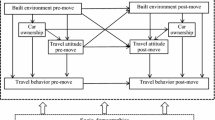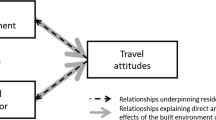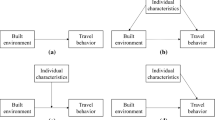Abstract
Suburban sprawl has been widely criticized for its contribution to auto dependence. Numerous studies have found that residents in suburban neighborhoods drive more and walk less than their counterparts in traditional environments. However, most studies confirm only an association between the built environment and travel behavior, and have yet to establish the predominant underlying causal link: whether neighborhood design independently influences travel behavior or whether preferences for travel options affect residential choice. That is, residential self-selection may be at work. A few studies have recently addressed the influence of self-selection. However, our understanding of the causality issue is still immature. To address this issue, this study took into account individuals’ self-selection by employing a quasi-longitudinal design and by controlling for residential preferences and travel attitudes. In particular, using data collected from 547 movers currently living in four traditional neighborhoods and four suburban neighborhoods in Northern California, we developed a structural equations model to investigate the relationships among changes in the built environment, changes in auto ownership, and changes in travel behavior. The results provide some encouragement that land-use policies designed to put residents closer to destinations and provide them with alternative transportation options will actually lead to less driving and more walking.


Similar content being viewed by others
Notes
Our data were collected at one point in time, but respondents were asked to retrospectively report a number of characteristics for a previous point in time as well as for the current time. So the data are different from longitudinal data, which are typically measured at two time points.
Total effects include direct effects and indirect effects. For example, if the variable X influences the variable Y2 without any mediating variables, this influence (X → Y2) represents a direct effect from X to Y2; by contrast, if X influences Y2 through Y1, this influence (X → Y1 → Y2) represents an indirect effect from X to Y2. Standardized effects, as in single-equation regression, are based on the coefficients of a model in which all variables have been standardized to remove scale dependence.
References
Anderson, T.W., Amemiya, Y.: The asymptotic normal distribution of estimators in factor analysis under general conditions. Ann. Stat. 16(2), 759–771 (1988)
Bagley, M.N., Mokhtarian, P.L.: The impact of residential neighborhood type on travel behavior: a structural equations modeling approach. Ann. Regional Sci. 36, 279–297 (2002)
Ben-Akiva, M., Atherton, T.J.: Methodology for short-range travel demand predictions: analysis of carpooling incentives. J. Transp. Econ. Policy 11, 224–261 (1977)
Bentler, P.M., Dudgeon, P.: Covariance structure analysis: statistical practice, theory, and directions. Annu. Rev. Psychol. 47, 563–592 (1996)
Boarnet, M.G., Anderson, C.L., Day, K., McMillan, T., Alfonzo, M.: Evaluation of the California Safe Routes to School legislation: urban form changes and children’s active transportation to school. Am. J. Prev. Med. 28, 134–140 (2005)
Byrne, B.M.: Structural Equation Modeling with AMOS: Basic Concepts, Applications, and Programming. Lawrence Erlbaum Associates, Inc., Mahwah, New Jersey (2001)
Cao, X.: The causal relationship between the built environment and personal travel choice: evidence from Northern California. PhD Dissertation, Department of Civil and Environmental Engineering, University of California, Davis (2006)
Cao, X., Mokhtarian, P.L., Handy, S.L.: Examining the Impacts of Residential Self-selection on Travel Behavior: Methodologies and Empirical Findings. Research Report UCD-ITS-RR-06-18, Institute of Transportation Studies, University of California, Davis, November. Available via http://pubs.its.ucdavis.edu/download_pdf.php?id=1057 (2006a)
Cao, X., Handy, S.L., Mokhtarian, P.L.: The influences of the built environment and residential self-selection on pedestrian behavior: evidence from Austin, TX. Transportation 33(1), 1–20 (2006b)
Cao, X., Mokhtarian, P.L., Handy, S.L.: Cross-sectional and quasi-panel explorations of the connection between the built environment and auto ownership. Environ. Plann. A. 39, 830–847 (2007)
Cervero, R., Duncan, M.: Walking, bicycling, and urban landscapes: evidence from San Francisco Bay Area. Am. J. Public Health 93(9), 1478–1483 (2003)
Chatman, D.G.: How the built environment influences non-work travel: theoretical and empirical essays. PhD Dissertation, Department of Urban Planning, University of California, Los Angeles (2005)
Crane, R.: The influence of urban form on travel: an interpretive review. J. Plann. Lit. 15(1), 3–23 (2000)
Crane, R., Crepeau, R.: Does neighborhood design influence travel? A behavioral analysis of travel diary and GIS data. Transport. Res. D. 3(4), 225–238 (1998)
Ewing, R., Cervero, R.: Travel and the built environment: a synthesis. Transport. Res. Rec. 1780, 87–113 (2001)
Finkel, S.E.: Causal Analysis with Panel Data. Sage University Paper Series on Quantitative Application in the Social Sciences, 07-105. Thousand Oaks, CA (1995)
Handy, S.L.: Methodologies for exploring the link between urban form and travel behavior. Transport. Res. D. 1(2), 151–165 (1996)
Handy, S., Cao, X., Mokhtarian, P.: Correlation or causality between the built environment and travel behavior? Evidence from Northern California. Transport. Res. D. 10(6), 427–444 (2005)
Handy, S., Cao, X., Mokhtarian, P.: Self-selection in the relationship between built environment and walking? Evidence from Northern California. J. Am. Plann. Assoc. 72(1), 55–74 (2006)
Handy, S.L., Mokhtarian, P.L., Buehler, T.J., Cao, X.: Residential Location Choice and Travel Behavior: Implications for Air Quality. Davis, CA, University of California, Davis – Caltrans Air Quality Project: 54. Available via http://aqp.engr.ucdavis.edu/Documents/Final_report_editted_updated1.pdf (2004)
Kitamura, R., Mokhtarian, P.L., Laidet, L.: A micro-analysis of land use and travel in five neighborhoods in the San Francisco Bay Area. Transportation 24, 125–158 (1997)
Krizek, K.: Residential relocation and changes in urban travel: does neighborhood-scale urban form matter? J. Am. Plann. Assoc. 69(3), 265–281 (2003)
Lei, M., Lomax, R.G.: The effect of varying degrees of nonnormality in structural equation modeling. Struct. Equation Model. 12(1), 1–27 (2005)
MacCallum, R.C., Browne, M.W., Sugawara, H.M.: Power analysis and determination of sample size for covariance structure modeling. Physiol. Methods 1(2), 130–149 (1996)
Meurs, H., Haaijer, R.: Spatial structure and mobility. Transport. Res. D. 6(6), 429–446 (2001)
Micceri, T.: The unicorn, the normal curve, and other improbable creatures. Psychol. Bull. 105, 156–166 (1989)
Morrow-Jones, H.A., Irwin, E.G., Roe, B.: Consumer preference for neotraditional neighborhood characteristics. Hous. Policy Debate 15(1), 171–202 (2004)
Mueller, R.O.: Basic Principles of Structural Equation Modeling – An Introduction to LISREL and EQS. Springer-Verlag Inc., New York (1996)
Raykov, T., Marcoulides, G.A.: A First Course in Structural Equation Modeling. Lawrence Erlbaum Associates, Inc., Mahwah, New Jersey (2000)
Schwanen, T., Mokhtarian, P.L.: Does dissonance between desired and current neighborhood type affect individual travel behaviour? An empirical assessment from the San Francisco Bay Area. In: Proceedings of the European Transport Conference (ETC), Strasbourg, France, October 8–10, 2003
Schwanen, T., Mokhtarian, P.L.: What affects commute mode choice: neighborhood physical structure or preferences toward neighborhoods? J. Transport Geogr. 13(1), 83–99 (2005a)
Schwanen, T., Mokhtarian, P.L.: What if you live in the wrong neighborhood? The impact of residential neighborhood type dissonance on distance traveled. Transport. Res. D. 10(2), 127–151 (2005b)
Stevens, J.: Applied Multivariate Statistics for Social Sciences. Lawrence Erlbaum Associates, Inc., Mahwah, New Jersey (1996)
Transportation Research Board and Institute of Medicine: Does the Built Environment Influence Physical Activity? Examining the Evidence – Special Report 282. Washington, DC. Available via http://trb.org/publications/sr/sr282.pdf (2005)
Acknowledgments
The data collection was funded by the UC Davis-Caltrans Air Quality Project and analysis was supported by grants from the Robert Wood Johnson Foundation and the University of California Transportation Center. Thanks to Ted Buehler, Gustavo Collantes, and Sam Shelton for their work on the implementation of the survey. Comments from several anonymous referees improved the paper, and conversations with David Ory helped clarify some of the ideas and interpretations presented here.
Author information
Authors and Affiliations
Corresponding author
Rights and permissions
About this article
Cite this article
Cao, X., Mokhtarian, P.L. & Handy, S.L. Do changes in neighborhood characteristics lead to changes in travel behavior? A structural equations modeling approach. Transportation 34, 535–556 (2007). https://doi.org/10.1007/s11116-007-9132-x
Published:
Issue Date:
DOI: https://doi.org/10.1007/s11116-007-9132-x




